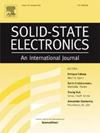基于自适应体偏置技术的数字LDO调节器改善瞬态响应
IF 1.4
4区 物理与天体物理
Q3 ENGINEERING, ELECTRICAL & ELECTRONIC
引用次数: 0
摘要
本文介绍了一种自适应体偏置(ABB)技术,用于改善数字低压稳压器(DLDO)在负载电流需求阶跃增加时的瞬态响应。ABB提出的技术检测电压欠冲,并动态调整DLDO开关阵列中pmosfet的体偏置,以降低其阈值电压,从而提高电流供应,帮助满足瞬态负载需求。与ABB-integrated DLDO,设计和模拟28 nm FDSOI (RVT)过程,达到减少输出电压低于峰值和恢复时间21.23%和41.13%,分别比DLDO操作没有ABB。散装CMOS工艺来验证我们的方法,我们还设计了ABB-integrated DLDO在180 nm批量过程和报告减少输出电压低于峰值和恢复时间13.69%和43.8%,分别。通过蒙特卡罗仿真证明了设计对不匹配和工艺变化的鲁棒性,表明所提出的ABB技术在DLDO中的可靠性能。本文章由计算机程序翻译,如有差异,请以英文原文为准。
Adaptive body biasing technique based digital LDO regulator for transient response improvement
This paper introduces an adaptive body biasing (ABB) technique for improving the transient response of the Digital Low-Dropout regulator (DLDO) during events of step increment in the load current demand. The proposed ABB technique detects voltage undershoot and dynamically tunes the body bias of the pMOSFETs in the DLDO’s switching array to reduce its threshold voltage, thereby boosting the current supply to help meet the transient load demand. With an ABB-integrated DLDO, designed and simulated in a 28 nm FDSOI (RVT) process, we achieve a reduction in the peak output voltage undershoot and recovery time by 21.23 % and 41.13 %, respectively, compared to DLDO operation without ABB. To validate our approach in the bulk CMOS process, we also designed the ABB-integrated DLDO in a 180 nm bulk process and reported a reduction in the peak output voltage undershoot and recovery time by 13.69 % and 43.8 %, respectively. The robustness of the design to mismatches and process variations is justified via Monte-Carlo simulations, indicating the reliable performance of the proposed ABB technique in DLDO.
求助全文
通过发布文献求助,成功后即可免费获取论文全文。
去求助
来源期刊

Solid-state Electronics
物理-工程:电子与电气
CiteScore
3.00
自引率
5.90%
发文量
212
审稿时长
3 months
期刊介绍:
It is the aim of this journal to bring together in one publication outstanding papers reporting new and original work in the following areas: (1) applications of solid-state physics and technology to electronics and optoelectronics, including theory and device design; (2) optical, electrical, morphological characterization techniques and parameter extraction of devices; (3) fabrication of semiconductor devices, and also device-related materials growth, measurement and evaluation; (4) the physics and modeling of submicron and nanoscale microelectronic and optoelectronic devices, including processing, measurement, and performance evaluation; (5) applications of numerical methods to the modeling and simulation of solid-state devices and processes; and (6) nanoscale electronic and optoelectronic devices, photovoltaics, sensors, and MEMS based on semiconductor and alternative electronic materials; (7) synthesis and electrooptical properties of materials for novel devices.
 求助内容:
求助内容: 应助结果提醒方式:
应助结果提醒方式:


